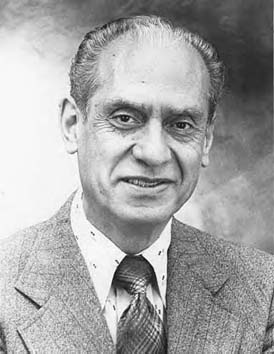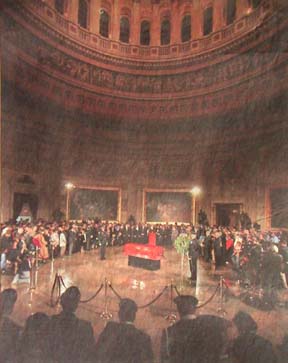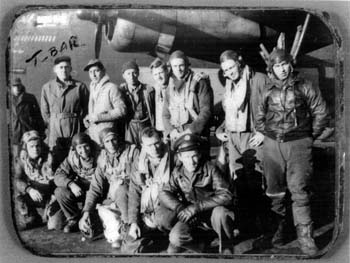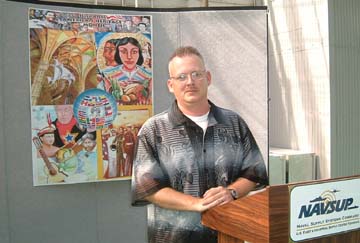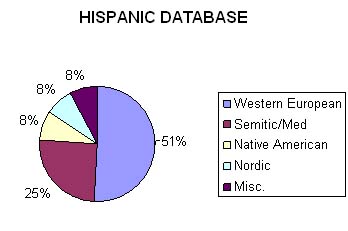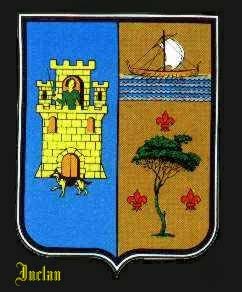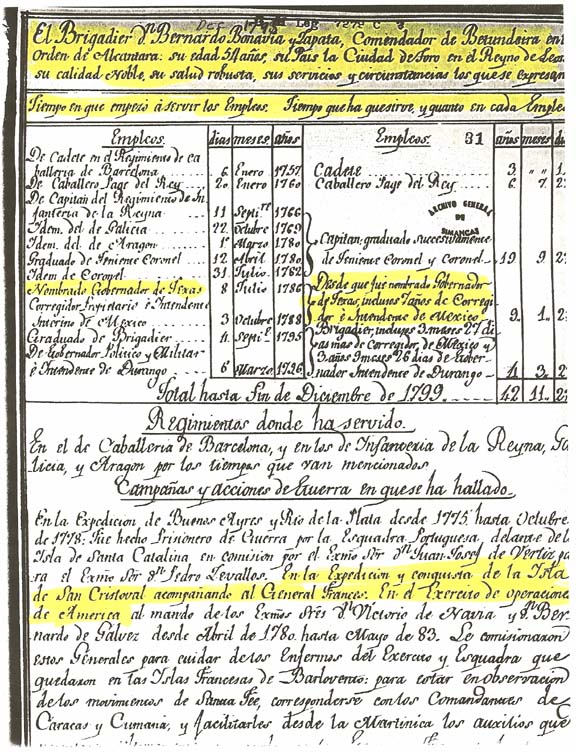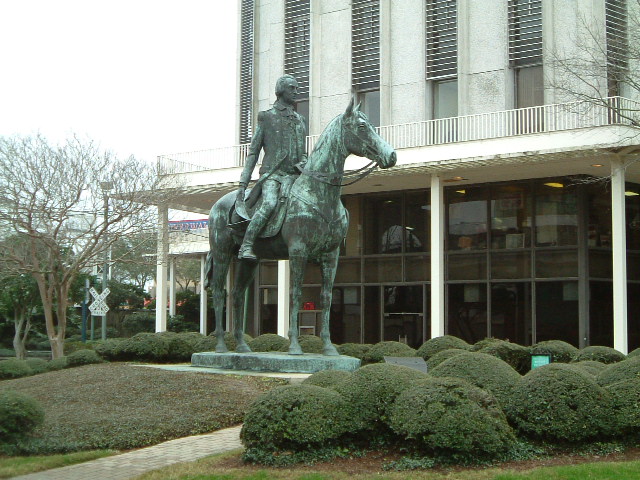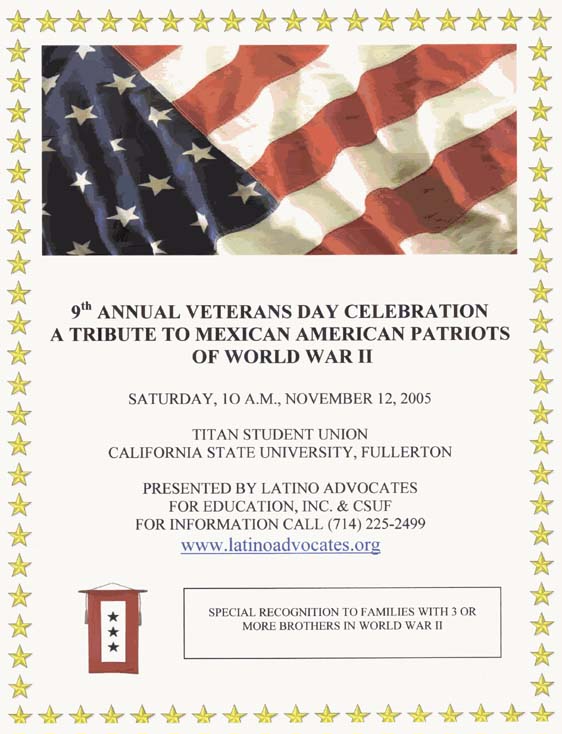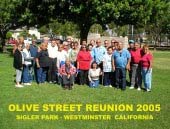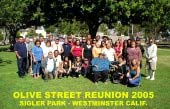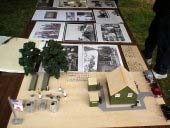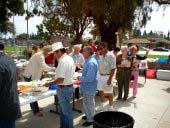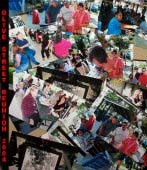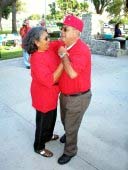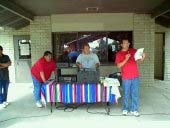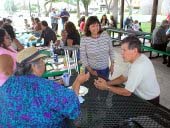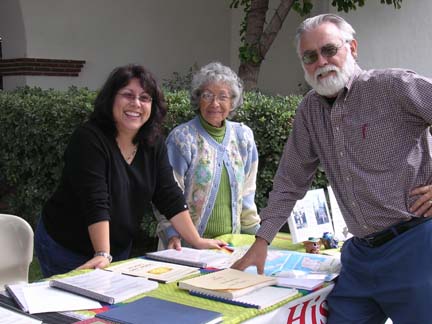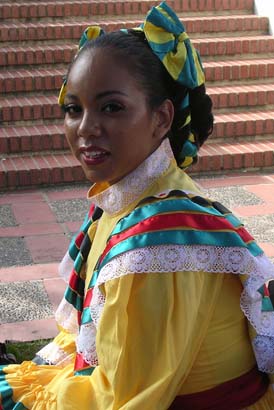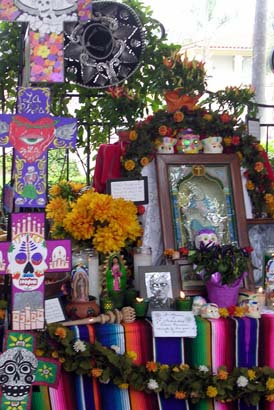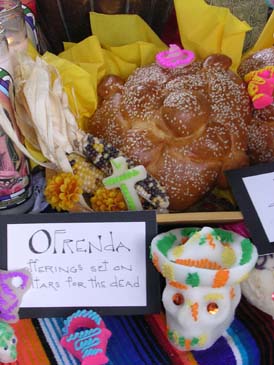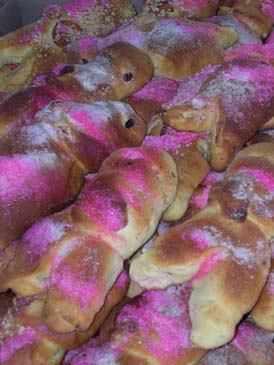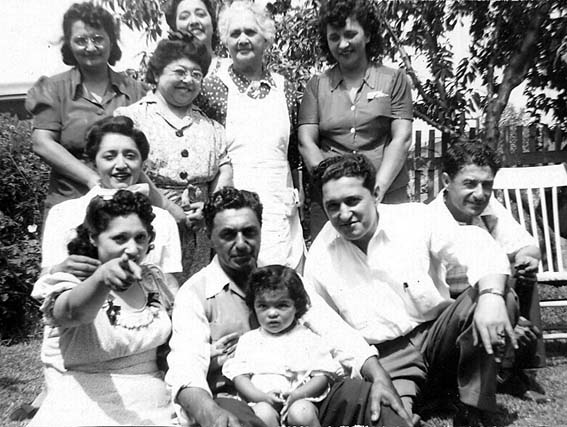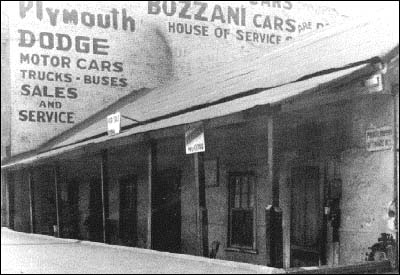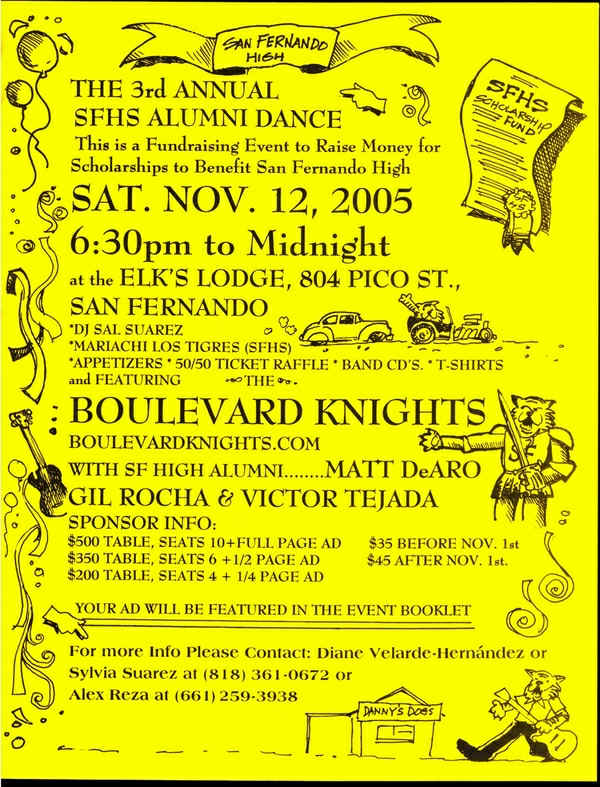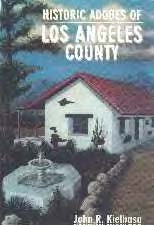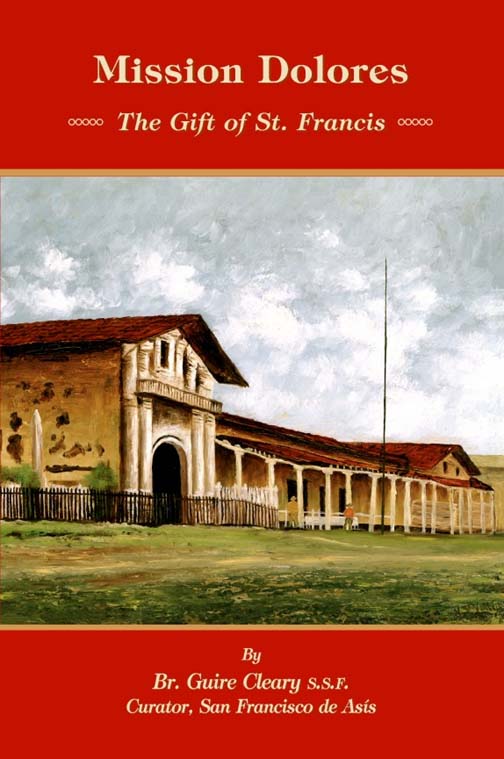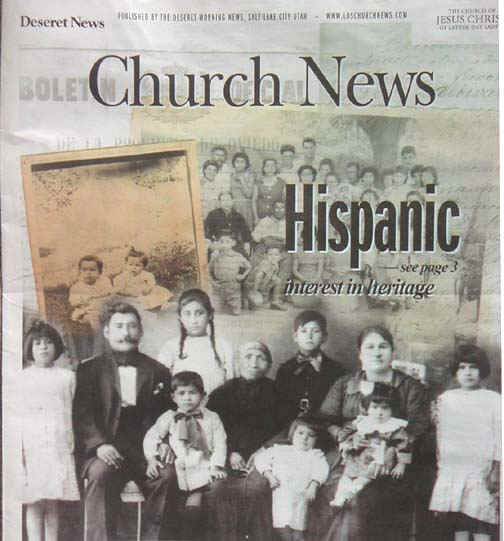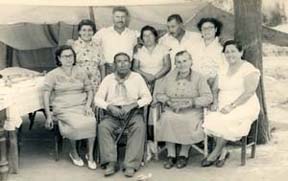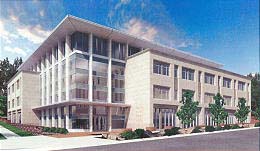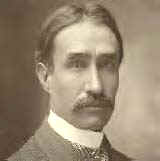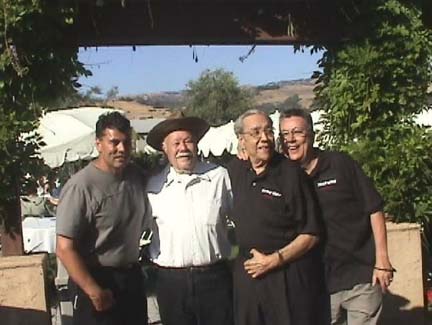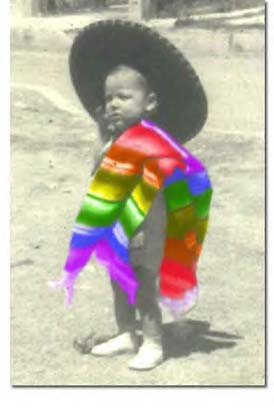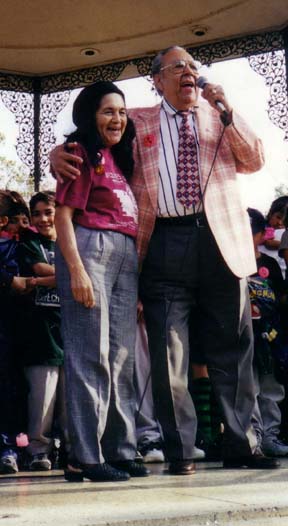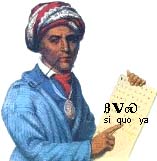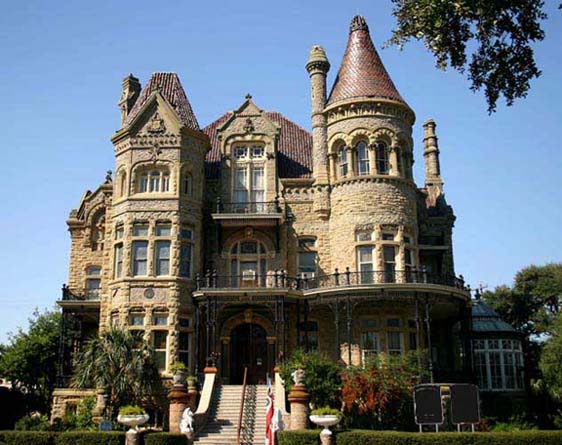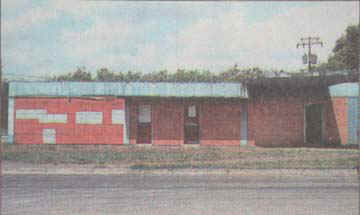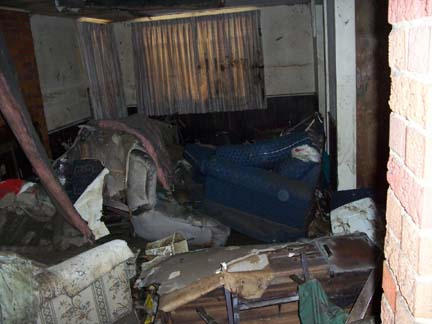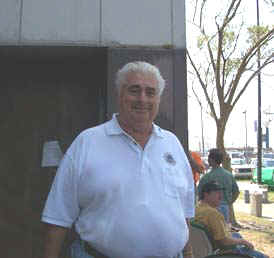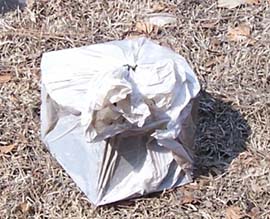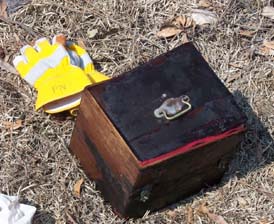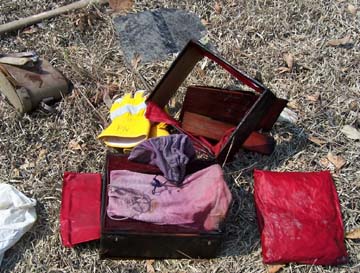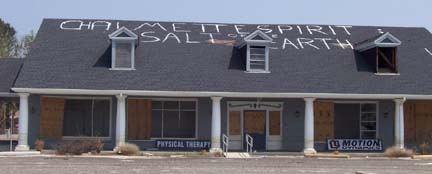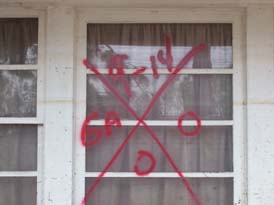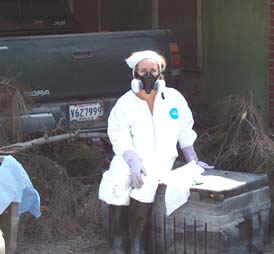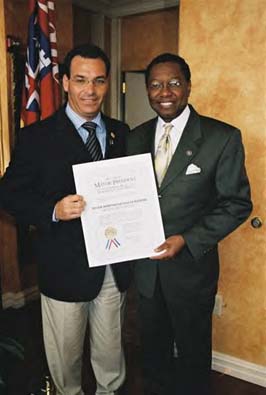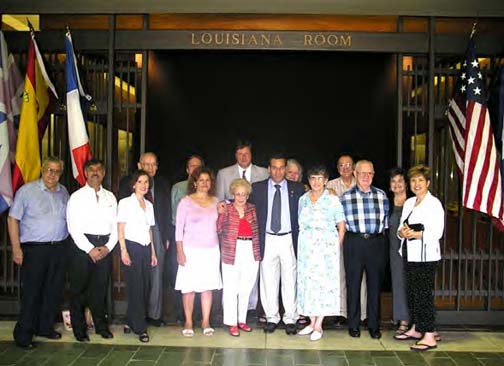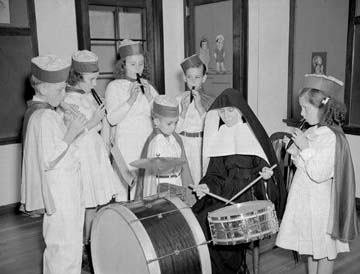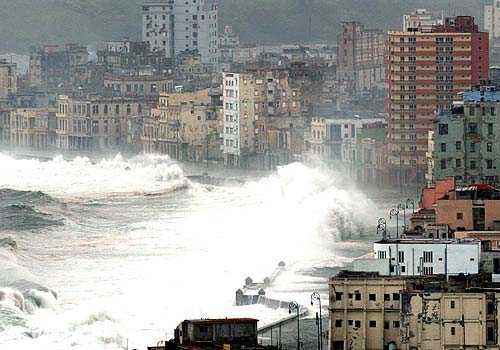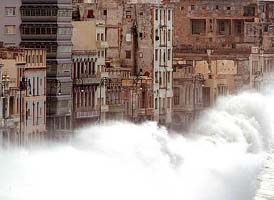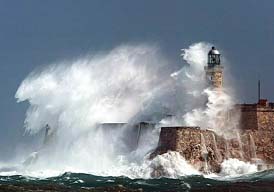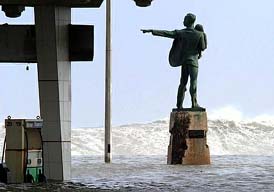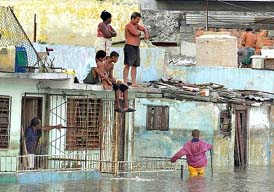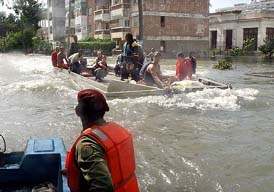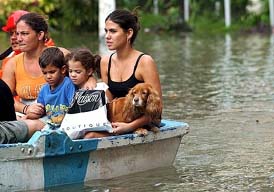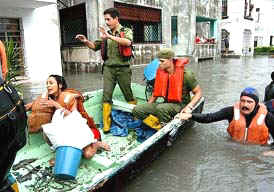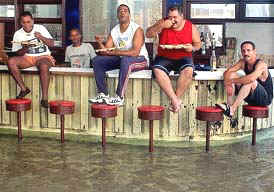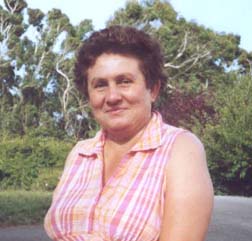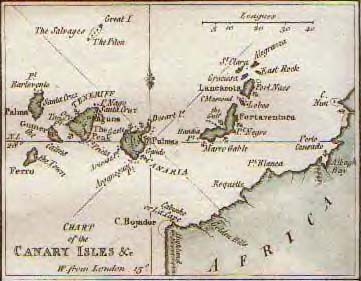Black Indigenous Mexico
Letter received from Theodore "Ted" Vincent
Fsln@aol.com, 10/19/2005 Dear Mimi Lozano:
What a wonderful web page is your "Black Latino Connection." I see you have an article by my UCLA friend Alva Moore Stevenson. Now that I have found you, I seem to recall that she suggested I look you up. And now I see your fine work and I notice that your page is quite large. I would like to be in communication with you about how you put huge quantities of historical material on the net, as, for instance does your friend John Schmall.
Presently, I have a kind of sizable page on AOL. I am Theodore "Ted" Vincent, author of "The Legacy of Vicente Guerrero: Mexico's First Black Indian President" (University Press of Florida, 2001) My "Black Indian Mexico" web page is
http://members.aol.com/fsln/index.htm
Over the past two years I have put together a 70 picture history saga titled "Gaspar Yanga and his Black Mexican Republic" which is a book crafted to emphasize the cases of positive social and political interaction between African and Indigenous Mexico. This photo book is in search of a publisher. Perhaps I will end up simply putting it on the net, a la the contributions of John Schmall.
I would like for you to see some of what I have to offer. A number of the photos for the book are in my web site. (It was put up early in 2000. The new book has a more Indigenous slant). Below is the text opening as adjusted for a Book Proposal..
Looking forward to further contact.
Ted
OVERVIEW OF: GASPAR YANGA AND HIS BLACK MEXICAN REPUBLIC
by Theodore G. Vincent 2005
INTRODUCTION (This is the actual book opening adjusted for this proposal)
“Those who read of his work know that ‘The Yanga’ fought for freedom, dignity and respect for his people, and know that his principles pertain to you, my friend... now, in the here and now, when millions of Mexicanos are in need of hope for justice and redemption
“Now you are Yanga.
“Those who read of him can be Yanga.
“Everyone ought to be Yanga.”
--Guillermo Sánchez de Anda, at close of his 1998 historical novela, “Yanga: Guerrero Negro.”
Why does Sánchez de Anda call upon all Mexicans to be an African who led a slave revolt of blacks in Veracruz back in 1570? That question is explored here in this 242 manuscript page study which also looks at: Why has Yanga gone from cult hero for generations of Mexican leftists, to the subject of web pages on four continents? Why is he honored with poems, short stories, a CD, a dance troupe, and a theater troupe that has acted out his story in Mexico, across the United States and in Europe? Why do young activists of the world wide “hip hop nation” sit and listen to university academicians lecture in Veracruz from the moldy data on the black rebel?.
Gaspar Yanga was a Prince in Nyanga, Gabon, who was taken in chains to the cane fields of Veracruz. He organized a revolt on the plantation and later fought off a Spanish army and obtained a treaty that made the Yangans “the first free people in the Americas” declares the banner hung in his city during its annual parade to the founder. Speaking of that parade, this book explores what inspired some participants in the late 1980s to put on ‘black face’ to compensate for not looking African. The practice was ended by paraders more sensitive to race, but not without heated discussion, such as recently occurred regarding the black stereotyped Memín Penguín cartoon.
This book shows how Yanga the African became a Mexican, all-be-it one with African customs, according to the records. The Prince of Gabon became Mexican by reason of the term’s ambiguous definition in those early decades of Spanish colonial rule. One way to be Mexican was to fight from the lower orders against the elite who hid themselves away behind hacienda walls and tall mansion doors. The elite didn’t want to be Mexican. Indeed, some were born in Spain, while those born here claimed allegiance across the ocean and called themselves “Espanoles,” Spaniards. Mexicans lived outside the walls, excepting those who worked for or serviced the elite, and could dream of their children of the master’s blood becoming “Espanoles.” Most people, however, could not so aspire. Among them, individuals who dared to stand up to the Spaniards were admired. They were the Mexicano heroes of countless old corridos, those long romantic ballads about macho peasants who fought the crooked sheriff. Gaspar Yanga took on a whole army, and his song didn’t have to end with the usual sad verse.
That a Prince from Nyanga has a city in his name in Veracruz is in line with others who get cities in Mexico, and with those who are honored on Mexican money. Whereas our dollar bills show only white men, the peso bills depicted the following in the year 2000. On the 10, there was the fighter for Indigenous peasant rights, Emiliano Zapata, Indigenous with some African heritage; the 20 had the pure Indigenous president Benito Juárez; the 50 had the intellectual and general, José María Morelos y Pavón - Indigenous African and Spanish; the 100 had the Texcoco poet King Nezahualcóyotl. A European looking person finally appeared on the 200 peso, and she is the feminist poet nun, Sor. Juana Inez, who was said to have had Jewish ancestry. Poets! Women! People of color! A heathen and a Jew! One may ask what is going on. One answer is that the color and diversity on the money is one side of a centuries long media war. In colonial times, the other side was the all-European looking portrait business, and now that side is seen daily in the preponderance of blonds on Mexican television.
Gaspar Yanga, being Mexico’s best known slave revolt leader, invites comparison with the best known in the United States. At first glance Yanga and Nat Turner have much in common. Both rebels shared the experience of labor in the fields, sugar for the former, cotton for the latter. Both represent a large forced migration. More than 250,000 enslaved Africans were brought to Mexico, while some 500,000 were taken to what is now the United States. Both black revolutionaries were under the whip and verbally abused. Both had a numerical advantage over the whites during the first hours of rebellion, and each rebel leader had a nearby geographic refuge, if they could fight their way to it. Yanga was a little over a dozen miles from one of the tallest and most rugged mountain ranges in the hemisphere.. Turner was roughly a similar distance from the Virginia/North Carolina “great dismal swamp” where there were already many black runaways, as there were already runaways in the mountains near Yanga.
The similarities are matched by contrasts, however. [[Editor:
I disagreed to Ted concerning the following statement as an
inaccurate and prejudicial generalization because many of my ancestors
came with wives and families.]]
Whites came to settle in Turner’s U.S., whereas whites came to colonial Mexico to get rich and go home. Whites came in families to the U.S., while very few Spanish women came to colonial Mexico.
A huge white mobilization responded to Turner’s 1831 uprising, and he was defeated. Whereas when Yanga rose in 1570 there were not enough Spaniards and hirelings to surround Yanga’s rebels on the plantations, and they fought their way to the mountains.
It was 1609 before Yanga was militarily confronted in a massive manner, and the majority of his opponents were Mexican conscripts rather than soldiers from Spain. The enemy ranks were larger than Yanga ‘s whole village of 500, which had children, women and the elderly, including himself “the Ancient One.” Over many days fierce of fighting, the Yangan strategy of retreat and attack in rugged terrain stymied the Spanish, who had hoped, at least, to force the Yangans to disband. Instead, they held together, while receding deeper into spectacular wilds that are now a Mexican national park. Rather than let Yanga get away, the Spaniards hoisted the white flag asking
negotiation. [[Editor: Yanga and his
men were preying on the merchants, stealing their goods. The negotiation
included ceasing to attack the merchant caravans.]]
Thus, Yanga obtained a treaty granting freedom, land and political autonomy in return for loyalty to Spain, adherence to the Catholic religion and other concessions, including a promise to return to their masters any future runaways who might seek sanctuary in the black republic.
Over the next two centuries the Spaniards tried legal and illegal tactics to abolish the little free town.
[[Editor: Please note, Spain did not break any treaties as the
U.S. did repeatedly. They should be respected for that.]]
But when the Empire fell in 1821, the enclave was still there. It had 718 people, a church, a mill and a distillery.
Today in Mexico, Gaspar Yanga has his festival, a tall statue, and a city and county in his name. Nat Turner apparently doesn’t have even a street name. Yanga benefits by being in a country where taking on “the man” takes precedence over anti-black prejudice. The writers in Mexico who, since the late 19th Century, have applauded Yanga‘s achievement, typically champion the fighting Indigenous as well. The Veracruz state politicians who in 1932 voted to change the name of the town of San Lorenzo to that of its founder, Yanga, voted at the same session to replace the Spanish name of San Juan de la Punta, eight miles down the road, to that of the Aztec fighter against the Conquistadores, Cuitlahuac. Black and brown being in the same struggle is a recurrent theme in Mexico and revolutionary muralists of the past century have memorialized many of these occurrences
Ironically, the writers, poets, and musicians who publicize the Prince from Africa in the name of Mexico are taking their payback for Yanga’s use of the Indigenous in gaining his freedom. Yanga chose his moment of revolution while the King of Spain faced many distractions.. The moment came during an intensification of a forty year guerrilla war being waged by the highland Indigenous. Their charismatic organizer, Chief Maxorro, had welcomed runaway slaves to his fold, but the Yangans were too far away to join, and they fled, instead, into the nearby Zongolican mountains, where the Zongolican natives had earlier capitalized on Maxorro’s war to demand and receive from the Spaniards a “Republica de los Indios” a grant of local autonomy. After Yanga fought off the Crown troops in 1609, his peace demands copied the clauses in Indio Republicas, and he obtained the hemisphere’s first Republica de los Negros. It is unfortunate that Nat Turner had no Indigenous with whom to coalesce. According to political scientists, outside help is one of the crucial factors for revolutions to succeed.
Contrasting time lines for Mexico and the land that became the United States are important to keep in mind. Native Mexico became involved in race in 1519 when the Spanish Conquistadors landed with two African slaves with them. The British didn’t land in Jamestown until 1607, and the first enslaved African in 1619, a century after the first in Mexico. The Mexican time line lengthens the multi-generational story of Yangan civic activism, and of the national leaders supported by the Yangans, such as Morelos and Zapata, and the first “Black Indian” president, Vicente Guerrero. A grandson of the latter was Vicente Riva Palacio, the prolific 19th Century scholar/novelist who brought Yanga to the public in writings that are still in print, and to which this book owes much.. The Yanga saga interacts with that of other heroes of his region, including Padre Juan Moctezuma of Zongolica, a descendant of the Aztec Emperor; and Catalina de Erauzú, the Basque gun toting duelist muleteer considered in some circles to be the Western World’s most famous lesbian of the 17th Century.
The story of Gaspar Yanga and his town flows through multiple complex concepts of race. The Spaniards labeled people white, black, Indio, or mestizo (Indio white), mulatto (white black), zambo (Indio black), castizo (mestizo and white), and more. Yangans were labeled black although the community was integrated with natives early on. And Yanga continues to be a proudly black community, even though those who look African have been a small minority in recent decades. Race is more socially than genetically defined in present day Mexico. A basic definition of Indigenous, for instance, is a person who spoke a Native language at home until age five. Today, a full third of the nation has some African root, notes Gonzalo Aguirre Beltrán, dean of Afro-Mexican studies. However, over half don’t know, or are in denial, he explains. An exception is the number of people of Yanga city and county who claim descendence from Gaspar Yanga.
CHAPTER 1. YANGA: THE MYSTIQUE (actual first chapter)
Lasting recognition rarely comes to “working class heroes,” even those who might “win one” against the oppressors. Rarer still, is recognition given to leaders of “the peasantry” from any year of the 16th or 17th centuries from anywhere in the Western World. For instance, no town or county is named after Chief Maxorro who launched the long Indigenous rebellion in the Central plains of Mexico, the rebellion which apparently was a key distraction to the Spaniards to help Yanga and his people to safely flee the cane fields in 1570. We don’t even know Maxorro’s full name.
Gaspar Yanga stands out among the Mexican masses that are generally mere anthropological curiosities, or faceless masses under the sombrero in accounts of the nation’s many revolutions. The enslaved Nyangan lives on because, through circumstance and timing, he has inspired writers who want to score political points. Accounts of him while he lived come largely from priests eager to show that their church was closer to “the people” than were the agents of the King of Spain. A priest detailed Yanga's 1609 military showdown, for instance. During Mexico's 1810-1821 war for independence there was intense freedom fighter work in the area of Yanga’s village, and we know of it largely from a chronicle written by a local priest.
Secular political use of Yanga was made by his townsfolk, who erected an oblisk engraved with the founder’s exploits. in 1788, a year when inspiration was needed to thwart those who would dissolve the little republic. Political points through Yanga were made between 1870 and 1890 by Vicente Riva Palacio, the socialistic scholarly grandson of president Guerrero. Riva Palacio wanted the nation to remember its black "third root." Continual reprints of his works on Yanga include the 1997 15th republishing of his "Los 33 Negros," in a run of 20,000 copies.
Yanga was next given prominance by Enrique Herrera Moreno, a medical doctor who was born on a former slave plantation near Yanga. In 1892 the then young practitioner published a detailed history of the struggle of the African for freedom. The chronicle seems a wish list for the revolution that came to Mexico in 1910, and in which Herrera Moreno was an activist at the national level for the cause of free public health care and public education for all.
In 1963 the 82 year old, self educated, Yangan campesino Leonardo Ferrandón published his memoirs, which highlight the 1885 Yangan agrarian revolt (the first in the state), and the wildly dramatic militancy of Yangan campesinos during the 1910 revolution. A full third of Ferrandón's work is a telling of the story of Gaspar Yanga. It is a story the old man felt was going to be forgotten, due to "the apathy of present descendants of the founder."
Leonardo Ferrandón passed on in 1968, year of a transforming event which sent young radicals in search of new heroes. The event was the massacre by the Mexican army and police of many hundreds of students at the Politecnico Institute's Tlalteloco square in Mexico City. The government that perported to represent the social revolution of 1910, had men with guns surround the students and fire at will from ground level and balconies into the large multitude. Within a year, student scholars were researching Yanga, the warrior who didn’t want to get near a large square, a warrior went who against the military might of the Spanish Empire and won the right to withdraw from the Empire. He was an alternative to the failed revolution of 1910. It saw the revolutionaries Emiliano Zapata and Francisco "Pancho" Villa sit side by side in the National Palace. What good was their triumph, asked the youth of 1968.
Study of Yanga was encouraged by visiting African Americans, who at home fought for “black power,” and who saw in Yanga a proto-type of their struggle for community power, notes former Student Non-Violent Coordinating Committee official Ron Wilkens. The town of Yanga was again radicalized, and in 1976 the “festival en negritud” was inaugurated and a 14 foot statue to the founder, showing him breaking his chains, machete held aloft for battle, was erected.
Thirty years after Tlalteloco, Guillermo Sánchez de Anda, a native of Orizaba, not far from Yanga, published “Yanga: Guerrero Negro,” (“Yanga: Black Warrior”), which tapped into the author’s spiritualist-left-wing circles, and beyond. Sánchez de Anda explained that his title was short for “Warrior for the Dignity of Oppressed Mexicans,” and it is in this context that he called upon everyone to “be Yanga.” Sánchez de Anda, himself carrying the blood of both Native and African Mexico, wrote his book of tribute in reaction to a massive police raid on the city of Yanga in February 1995. A year earlier the highlands of Chiapas were overrun in the Indigenous "Zapatista" rebellion. A standoff developed and negotiations began. Talks stalled early in ‘95, and President Ernesto Zedillo took dramatic action away from the negotiation table It was the afternoon of February 9, Yanga was rushed from two sides by "a great quantity of car loads of agents from the PGR," the federal police, assisted by car loads of state police, and assorted car loads of officers in unmarked cars who came in search of Zapatistas. Amnesty International's investigation of the incident said fifty federal police vehicles took part. Pistols and rifles in hand, the officers stormed into two houses in a barrio of mostly Indigenous people in the black town. The houses were occupied by police through the night, while other officers formed a perimeter and scanned, for a possible rescue attempt on those in the homes. The next morning five men and two women were whisked to helicopters that flew the captives away.
The incident was quickly publicized, notably on web sites of the Chiapas guerrillas, and it was the talk of intellectuals in the Veracruz state capital of Xalapa, site of the Universidad Veracruzana, a center for the study of the African heritage in Mexico, and home for many writers about Yanga. No one could get the names of "the Yanga 7." Phone calls to city officials in Yanga received a terse explanation that there was said to be a stash of weapons for Zapatistas in the homes raided, but the names of the arrested were not given. One scholar drove to Yanga and asked about the neighborhood. The only person willing to talk said that those taken were not natives of the city
.
Had President Zedillo acted out of fear that the Zapatistas were plotting a wider revolt? The pro-government media gave this view. The opinion of those opposed to the government stance on the Chiapas rebels was summarized by the German on-line newspaper, "Poonal," which said that Zedillo wanted to "release the army," and crackdown against Zapatista sympathizers, and his tactic was "justified by the doubtful 'discovery' of military material in houses in the capital and Yanga."
The coffee house chatter in Xalapa was about the odd fact that Zedillo sent his swarms of PGR agents only in the
capital, in an outlying town of the capital and in Yanga and Zongolica (another of the many parallels between those two locales). On second thought, the choices of Yanga and Zongolica seemed understandable in light of their rowdy history. Regarding Yanga, four months earlier a number of newspapers had run a statement by the leader of an Afro-Mexican cultural center in the black township of Cuajinicuilapa over on the Pacific coast, in which she declared, "If the Indigenous are organizing, the blacks should organize, too." No doubt, the PGR expected it to happen, and appeared to conclude that Yanga was the likeliest of the small number of towns around Mexico with a substantial African population to form a link with the mysterious Zapatistas in the jungles of Chiapas. The Yanga 7 were convicted a year later and sentenced to lengthy prison terms, but then in December of 1996 all charges were dropped and they were released. Around this time troops that were stationed in the Zongolica were withdrawn. No Yangan weapons stash was ever produced by the authorities. Amnesty International reported that the 7 had been tortured in their homes, and had spent months in solitary confinement. The 7 are, Hermelinda Garciá Zapagua, Rosa Hernández Hernández, Ricardo Hernández López, Hilario Martínez Hernández, Martin Trujillo Barajas, Luis Sánchez Navarrete, and Alvaro Castillo Granados.
The National Human Rights Commission, Amnesty International and others declared that the 7 had done nothing illegal, but that did not mean the prisoners were non-political. Or, that their experience had not made them political. Two weeks into her confinement Rosa Hernández Hernández told a human rights investigator that the police "insisted I was a Zapatista," and for this, "I was wrapped in a wet cloth and given electric shocks all over my body." Rosa Hernández told the press at her release, "Behind us are two years of imprisonment; they were difficult times, without being able to see our families. But we continue being Zapatistas, just like everyone else, like any other organization, as any other open struggle."
Yanga resident Rosa Hernández Hernández wants everyone to be a Zapatiasta, Guillermo Sánchez de Anda wants everyone to be a Yanga. It would appear that a militant Mexicano might be one this year, and the other the next. The Zapatistas of Chiapas have included a sizable minority of non-Indigenous from the movement’s first public act, the uprising of 1994, notes anthropologist Araceli Burquete, herself a Nativa from Chiapas. One well known “mestizo” in the movement is its public relations spokesperson Sub-Comandante Marcos. Affected Indigenous Zapatistas and affected “black Yangans” represent a play element regarding identity in Mexico. But the need for seriousness arises now and then. In Chiapas the radicals work hard to preserve Indigenous language, customs and clothing. Among Yangans there are those who maintain music forms from Africa, while others work to keep alive a town history which when put to music will be one very long corrido.
Let us now go to the libretto for that corrido.
Mimi:
photos for this book that are not on my web page include, 4 from Yanga's homeland in Gabon, 3 of the Zongolican mountains where Yanga lived while a cimarron, 3 of present day Zongolicans engaged in daily work, a number of photos of Indigenous ruins in the Yanga region and elsewhere in Veracruz - these pics showing how it was unavoidable for Yanga to be churning up a potent old civilization as he plowed the cane fields. There are three pics showing the variety of music at the Veracruz Zocalo. From history files I have 2 Viceroys who dealt with Yanga, Catalina de Erauzu who ran mules in Yanga's cane frields and is said to be the Western World's most flamboyant lesbian of the 17th Century...and more.
|
|
[[Editor: I wrote to
Ted and said that I objected to the Spanish being made the
historical "bad guys". Ted responded expressing an
perspective with which I agree. (see below). Men are swept along in the
circumstances of their period. It is unreasonable to judge our
ancestors by current social circumstances. Issues of the rights of man
have brought about a 21th century conscience, yet slavery is still an
accepted practice now in parts of the world. I have found among my
ancestors evidence of buying, selling, and among the first in Tejas
to give freedom to slaves in the 1600s.
www.somosprimos.com/blacklatino/bl.htm]]
Dear Mimi,
I think Hollywood and jingoistic politicians have given villains a bad
name.
My idea of a villain is not an ax murder, but rather someone, who by
obligation of position in society, or position in the family, makes
important decisions that happen to negatively effect some other people.
Below I give you the man I consider the most fascinating villain of my
Yanga book, a man without whom the story would not be nearly as
interesting. I very much would like your reaction to my treatment of
Viceroy Velasco II.
I am willing to adjust my presentation, for my ultimate goal is to show
how Mexico has racially blended - which I like to show was through a
number of complex and often convoluted expressions of militant opposition
to injustice.
Ted
CHAPTER, THE CHIEF AND THE VICEROY. AFTER DWELLING ON THE PERSONALITY
AND SITUATION OF YANGA THE TEXT READS:
To deal with the threat,( from Yanga) Spain had Viceroy Luis de Velasco
II, Marquis de Salinas, who came in 1607 from serving a term as Viceroy to
Peru to take a second term as Viceroy of Mexico - a term involving a
crucial period for Gaspar Yanga and his people.. From Velasco’s
reputation in many histories, Yanga couldn’t have asked for a better
Viceroy. But in dealing with a tyranical Empire one should be careful what
one asks for. Luis de Velasco II felt himself a modernizer. He is know in
optometry history as the first person in the New World to wear corrective
lenses. He began a sewer system for Mexico City, and to show he was close
to the people, he took a shovel and worked the dig on the project’s
first day. Velasco’s father was Viceroy 1550-1564, and also being modern
in mind, founded Mexico City University. A young Velasco II had fulfilled
bureaucratic jobs under father’s reign. Father detested the
"spoiled children" of Conquistadores and Indias, who pestered
him for jobs. Father found the mestizos and blacks disreputable and
"frightening." Indios were children in need of guidance, in the
opinion of both Velascos. The latter wrote to King Felipe that "it is
not true that the Natives are without reason...The Jesuit educators have
had good results with the Indios they have selected to tutoring."
Father Velasco arrived in Mexico in 1550 with instruction to enforce
the abolition of slavery of the Indians. In debates in the King’s court,
the priest Bartolme de las Casas had gotten slavery in the New World
ended. But outcry from slave owners forced reconsideration. In a
"compromise," Las Casas won abolition for Indios, on the
argument that increased importance of Africans could fulfill the labor
needs. The rape of Africa was on. Indios were still being held in
servitude in Mexico when Velasco I arrived, but he promptly freeded some
150,000 enslaved Indigenous Mexicans.
Having satisfied his King, Luis de Velasco I then faced irate hacienda
and mine owners, who convinced Velasco to institute a form of serfdom for
Indios that was little removed from slavery. Chief Maxorro’s rebellion
was one consequence. The Republica grant to the Zongolicans in 1556 was,
in part, to keep them tranquil while the highlands were a bloody battle
ground Velasco Sr died on the job in 1564, allegedly worked to death over
the Indigenous rebellion.
Velasco Junior took the reigns for his first term as Mexico Viceruy
(1590-1595) with grand plans for the Indios, starting with ending the war
of the Chichimecas. Junior send emissaries to the rebel leaders urging a
conference for peace. Velasco II had seen the failure of all out war, the
"strategic hamlets," the "green zones.". Velasco got
warring chiefs to come to Mexico City, where he greeted them personally,
showed them around the town, and then made a peace pact, which in addition
to granting pardon and giving land, included a clause that from time to
time the Spaniards would supply the Indians with a large quantity of beef
- at this clause there were murmurs from members of the Viceroy's court,
that this was paying tribute to Indios, nullifying the tribute the chiefs
agreed to pay to the King. It was bad enough, argued the critics, that
"savages" who killed Europeans got peace. Velasco had an answer
for his critics. He, more than some others with his post knew the Viceroy’s
game was two sided if not three sided, considering the obligation to first
serve the King of Spain, second placate the privileged Whites of Mexico,
and then, when possible, attend to the uplift of the masses. Velasco paid
to have a few thousand loyal to Spain Tlaxcalan Indians given land in
strategic spots around the former Chichimeca run region, and he put a
clause in the treaty that the rebels accept into their area an inordinate
number of priests and friars, these measures achieving the Chichimeca
"subjugation," according to one historian.
Peace on the planes brought opportunity for Velasco II’s greatest
leap forward for Indios. He explained to King Felipe that the civilizing
and educating of the Indigenous that Jesuits took off the streets of the
capital, could be done on a grand scale, if Indios were taken out of their
traditional mountain habitats and made to live in special communities in
the valleys, i.e. on Indian reservations. Support was loud from land
speculators eager to grab the Indian mountain land, which was better than
that of the grassy planes where the Natives would be placed. Knowing
Chichimecas wouldn’t go for this, the first to be displaced were those
living in mountains closer to Mexico City. The anger and despair of the
Natives chosen was intense. One distraught father killed his wife and
children, burned his home, and hung himself. At news of this, Velasco
canceled his reservations project. Another innovation he had to cancel
involved tribute taxes. He decreed that Indios could pay 1 Real of their 8
Real tax with a chicken. A chicken sold for more than 2 Reals at the
market. A tax revolt ensued as word spread that tax collectors were
sending the King 1 Real while pocketing the second one. In the interim,
not enough taxes came in and Velasco tripled the tribute for Indios and
Blacks. This unpopular measure was rescinded by the next Viceroy before
Velasco had left Mexico City..
Regarding Africans in Mexico: One of Velasco Junior’s first acts of
his second term, was to authorize the hiring of the De Baena cimarrones
for militia duty. But almost immediately afterward, he sent an angry
letter to the mayor of Veracruz complaining of an out of control slave
runaway situation and demanding "within 15 days" a detailed
report on the mayor’s efforts to eradicate cimarronage in the port area.
For Gaspar Yanga, the hiring of De Baena was a critical factor in the
decision to settle down in a village. The 67 or 68 year old Yanga, no
doubt, acted upon knowledge of certain facts about his 67 year old
adversary. The Zongolicans with whom Yanga had trade relations probably
informed Yanga that Velasco’s father had been Viceroy, and had granted
them their "Republica de los Indios." and that grant was one of
the larger ones. On the other hand, Velasco Jr. began his first term as
Mexican Viceroy by awarding a number of Spaniards, legal deeds to pieces
of. Zongolica.
The Yangan raids on the lowlands in 1607-1608 frightened whites around
the colony. In the capital, rumors flew about blacks organizing for
rebellion. Incidents of blacks acting in what might be called an
"uppity" manner were widely discussed. A rumor of December 1608
was that blacks were about to crown their own King, for whom a war to
massacre all whites would be launched.. The date for the uprising was said
to be January 6, 1609. Whites urged their Viceroy to act in advance. A
delegation of blacks told him that the rumors were unfounded. Luis de
Velasco II was about to pull one of his two sided maneuvers.
The morning of January 6, a crowd of anxious Spaniards gathered in the
town square and clamored for protection. Viceroy Velasco appeared, and
ordered that a number of blacks be taken from their cells in the town
jail, and brought to the city square. There, they were publically whipped,
and Velasco declared that the conspiracy had thus been thwarted. His
cavalier attitude toward the alleged black conspiracy did not sit well
with the more frightened of the city's Spaniards - who worried that this
Viceroy might not take threats seriously enough.
Luis de Velasco II already had his response in play. He had quietly
prepared an organized military expedition against Gaspar Yanga. Velasco
ordered the Spanish army Capitán Pedro González de Herrera to marshall
troops in Puebla. There were, depending upon the source, some 100, or,
over 200 Spanish soldiers armed with muskets, and others pulling small
canons. They were joined by between 300 to 450 enlisted and conscripted
mestizos, Indios, blacks and mulattos, plus an assortment of
"adventurers." Velasco ordered that no black be permitted to
proceed from Puebla toward Veracruz, lest a warning of the impending march
be given. The order angered merchants who's mule drivers were thus
detained, and the crowds of recruits in the streets upset wealthy Pueblans,
but Capitán González was a native of the city and gave assurance that
the army would soon move out. The transportation ban did not stop word of
the mobilization from reaching the Yangans, and it was said that
consternation spread through the village, women wept and men rang their
hands and shouted to God that it would be unjust to have to move from
their new home.
Yanga and his "council of elders" met and decided not to flee
into the wilds, but to stay and fight, even though the Spaniards would
outnumber the rebels in any showdown, and the latter's fire power
consisted of a few muskets and not much powder, to compliment swords, bows
and arrows, spears, knives, hatchets and the Indigenous rock propelling
sling shot. A small Spanish scouting party set out on January 26th, and
was ambushed by Yangans. One of the Spanish soldiers was captured, and
upon discovery that he could read and write, he was taken before Ancient
One. A quivering young man was told, "Do not fear, Spaniard, for you
have seen my face, and (still stand before me) so you cannot die."
Was Yanga borrowing a line from Aztec ritual, in which a commoner who saw
the Emperor’s face had to be absolved by the Emperor or die? Yanga then
dictated a letter to Capitán González, who was said to have reacted
angrily after reading the message, no doubt in reaction to the following
words from Yanga.
"We have removed ourselves to this place, because you have,
without any right, declared yourselves masters of our freedom. And because
we favor a God who's cause is just, we have over a long period fought and
won glorious victories over all the Spaniards who have been sent to
apprehend us. In that we assault the places and haciendas of the
Spaniards, is no more than recompense that we take by force of arms to
obtain what is justly denied. You have shown yourself incapable of
thinking of methods for peace, being locked in your instructions to find a
solution through armed subjugation of us; and considering your cowardice
and ignorance of the roads, we send you a messenger, a man we return to
you, not wishing to kill him, in that we want you to have a guide to ease
your work of finding us."
Proper decorum required that González refrain from tearing up the
insulting note. He passed it on to the authorities, who showed it to the
Viceroy. The letter contained a lengthy list of conditions under which
peace might be obtained, and Yanga stated that these terms were arrived at
"by unanimous decision of the council of elders." The Indigenous
of Mexico also worked politically through a "council of elders."
The similarity of the Yangans' terms to those through which Indian groups
in Mexico obtained autonomous "Republica de los Indios" status
has startled historians, as they must have startled Viceroy Luis de
Velasco II.
Yanga presented the standard request for self-government. He asked that
he have a Republic governed by his own people who he declared had selected
him to be their Chief, and he wanted that honored. Yanga asked that no
Spaniard be permitted to live in the Republica, except a "justicia
mayor" (and here Yanga used the term in Indigenous Republicas for an
outside legal supervisor). Yanga agreed that he and his people were
obliged to pay tribute to the King of Spain, to follow the Catholic
religion, and to perform public service to the government of the King.
Treaties founding la republicas usually stipulated that past offenses
committed against Spanish law were pardoned. The republicas were
Hispanicized versions of the self-governing, tribute paying, "ejidos"
of the Aztec Empire. Historians MacLachlan and Rodríguez note that while
the "la republicas" bought peace, they were economically
"separate and not equal" institutions. Yanga no doubt knew the
choices. He chose to establish his village in the Zongolica, where freedom
came at a price, if the free Nativos of that range were paying then as
they pay today for their independence. A 2005 report by the State of
Veracruz gives Zongolica the dubious distinction of being the most
economically marginalized of all Mexico’s ejidos.
Gaspar Yanga's message to the Spaniards emphasized that he wanted only
to live in peace; and that the King of Spain could rest assured that Yanga’s
people would follow that path. The African leader’s addition of insults
and bragging to González might be considered a ritual of psyching of the
enemy before battle.
Luis de Velasco II ordered the troops to march, while comptemplating
the alternative course.. Behind the scenes, he had advocated to his
superiors in Spain for a peaceful solution. In a June 23, 1608 letter to
the head of the Council of the Indies, Velasco outlined the options, and
his convoluted wording revealed a heated state of discourse within ruling
circles.
"Regarding the pacification of the black runaways, one can sees wide
extremes on this difficult issue, with opinions differing on whether the
most convenient means are policies of peace or of war, and for each there
is much about which I have communicated to the Real Audiencia (court
Council in Mexico City),...and the material has experienced contrasting
interpretations... The visitor (the priest) and I are in accord with a
number of other intelligent persons who proclaim for a peaceful solution,
in which we grant them their freedom while putting upon them limitations,
this path removing the possibility of a war, which costs a great deal of
money, that the slave masters of those who fled do not have to give, nor
is there good reason for the finance ministry to give it, and if a war is
fought, the end is doubtful, considering the location that they are in,
and taking into account the many who will die... the most secure path
appears to be pursued through peace."
Was there more to this statement than a display of reasoned politics?
Could it have been influenced by a desire to not become like his dad, an
overworked Viceroy dying at his post while trying to put down a rebellion
of poor people? Velasco's son faced demands of around 400 blacks that they
be liberated. Junior had freed the comparative handful of cimarrones with
De Baena, but no where in the colonies had a large group of black runaways
won freedom, (with one short lived exception in Santo Domingo). To grant
land to a sizable group would entice those still in bondage to flee to the
sanctuary. Gaspar Yanga had anticipated this worry on the part of the
Viceroy. His statement to González offered that, if granted freedom and
land, he would return to their masters those slaves who in the future
might seek sanctuary.
Trust on this clause would be needed. The wealthy in the colony, and
those in Spain who banked on mines and plantations in Mexico, could not
fathom a free area to which slaves could flee. They believed the economy
was balanced gingerly thanks to slave labor, and that only force could
make a person work the most dangerous mine pits, or sweat in the heat of
the sugar vats. (improved working conditions were rarely considered in the
17th Century). Velasco experienced the shaky state of business from his
Viceroy schedule of petitions, appeals and regulations. He also knew from
his father's experience, that a botched abolition of slavery for Indios
had resulted in disaster. And he knew that slave owners would stampede the
Viceregal palace if he began negotiations with Yanga without first trying
seriously to subdue the black rebel militarily. With good fortune,
Commander González would be successful enough to preclude a Yangan
regrouping and counter-attack, as had suffered father’s troops. Ideally,
González might administer a defeat that left only scattered individuals,
and even if a Yanga managed to keep a group intact, where could he find
another spot in the precipitous Zongolica for his band? He would have to
disperse and, Velasco could conjecture, over time, most could be collected
by those slave catchers who worked on consignment. At the least, Yanga
might be forced to negotiate a settlement.
Yanga’s attitude at this moment, deduced from subsequent events,
appears to have shared the Viceroy’s view that a military showdown was
needed, after which negotiations could follow, assuming, of course, that
proper humiliation of the other had been administered. The African leader
had but few muskets, his fighters were more accustomed to using clubs,
swords and and daggers than bows and arrows, and his locale didn’t have
much in the way of stalks for spears. There were, however, plenty of
rocks, and a little training from his Indians in the Aztec slingshot would
be helpful, particularily since the plan was to use the thickly bushed
canyon side below his village for an ambush. Ideally, the Spaniards would
slink away from the canyon in defeat and Yanga would reitterate his desire
for a peaceful settlement. But if the ambush failed to deter the enemy,
the fall back plan needed for success only that the cimarrones retained
enough fighting power to keep the Spaniards from rushing at them while
they retreated with their women, children and elders, not in search of
another locale in the Zongolica, but to into the freedom of the wasteland
that few ever bothered to esplore, much less enter with an army. The
Spanish mistakenly considered the area part of the Mixteca,a nation half a
hundred miles to the west. There were a scattering of Mixtecans, along
with a few Zapotecans, Popólacans.and Mazateopanes. Not enough of any one
group to argue over territory. It wasnt that the wasteland had to place to
grow crops. There were some. The problem was that the region was a morase
of steep mountains and narrow valleys, none leading to anywhere in
particular. It was off any beaten track. Today, a quarter of it is under
the waters behind the Miguel Aleman hydroelectric dam, one dam project for
which there were few villagers to complain about their land being
inundated..
THE BATTLE
Capitán González marched from Puebla to the wild applause of the town
folk. parades of soldiers, Viceroys, and Bishops were vital instances of
noise and celebration in the repressive world of colonial Mexico.
González made the two day march across the mile high plateau of sage
brush, corn fields and aguave plants to the great pass on the side of Mt.
Orizaba that led down to the sugar belt. While descending the pass, and
following his guide onto a side path, González and his company came to a
spring frequented by the Yangans. Abandoned utensils made Gonzalez wonder
if a panic might have over taken the enemy. The Commander camped for the
night at a spot just below a steeply inclined stream bed that González's
guide surmised was but a few miles from the rebel village.
Two priests were among the Royal force, and that night Padres Juan
Laurencio and Juan Pérez circulated among the troops giving blessings and
well wishes. The clerics were along on orders of Luis de Velasco. The two
men were the advance guard of Velasco’s plan to propagandize Yangans
with an abundance of religion, as the Chichimecas were propagandized after
their 1590 treaty.
The Yangan warriors were not in their village that night. They quietly
descended to take positions behind trees and boulders on the canyon where
the Spaniards were expected to progress one or two abreast along the
narrow stream bed. From a battle account we know that the locale was
somewhere in the lower canyons of the Zongolica/Rio Blanco area. The
typical canyon had foliage quite thick enough to provide cover, yet in
places it would be too thick for the Yangan archers, spear throwers, sling
shooters, or holders of one of the few muskets to have clear vision of the
stream bed. Still, if all went well, the soldiers of the King of Spain
would be strung out and subject to a deadly barrage. The Ancient One
remained above the fray in his village, declaring that he had full
confidence in his commander De La Matoza.
Padre Laurencio wrote a detailed account of the González expedition,
and from that and scattered additional reports it is known that the
Spanish forces struck camp early the next morning and proceeded cautiously
up the canyon. The footing was difficult and military precision gave way
to stumbling over stones, and getting soaked from the sloshing waters of
the stream. A playful little dog of one of Capitán González's
conscripted Mexicans scampered well ahead of the Spanish lines. González
watched the animal turn to the bushes, wag its tail, and then bark. The
ambush had been exposed. The Spaniards were not yet in the trap. A fierce
fight ensued. Padre Laurnecio described it from his vantage point.
"Me and my companero were without arms, having confidence in God. We
took from our belts the sacred incense which we spread for those who were
risking death... They threw at us huge crude rocks and arrows. It was a
miracle that our Capitán was not killed... A rock hit me, and then an
arrow, although at the time I did not feel wounded, afterward I noticed
blood all over my left leg, which took fifteen days before the infection
went away. A soldier beside me was hit by an arrow, and finally, there
were a great many of our side wounded by the stones, and by the arrows
that were tipped with iron, showing that they had an iron forge, which we
would later see in their pueblo. We were hurting the enemy as they hurt
us, and we finally moved forward after we brought up our rear-guard of
friendly Indios with bow and arrow, and with our blunderbusses firing, we
obliged the blacks to leave their hillside spots and flee to their
village."
González thought of ordering a rapid pursuit, but changed his mind,
considering the yards upon yards of dead and moaning bodies from both
sides laying ahead of him. After a rest, González ordered the remainder
of his troops up the canyon toward Yanga's little town. They proceeded
slowly, lest there be another attack. It was turning dark when Capitán
González's party entered the village to find it deserted, except for a
dying wounded man, and two of the India wives with their children.
Laurencio surmised that the village had not been deserted long, for he
found candles still burning in the chapel. One of the Indias told him that
Yanga had prayed there during the battle. A collection of arrows had been
placed about the chapel alter in a strange formation. The priest
interpreted this as a sacrilege, and he wrote in his diary, "I thought
that although we were beyond the fighting, I could not wait for the
fearful retribution which God would surely throw at these cruel
barbarians."
The women were asked where the villagers had gone, and they said it was to
where no one could catch them because they had the spirit of freedom. They
had left much behind. Laurencio recorded collecting swords, axes, a few
blunderbusses, along with coins, salt, butter, corn and other items.
"Although we had not defeated the enemy we had seriously weakened
them," wrote the priest. The little army of the King was also
weakened. González gave his soldiers the pleasure of occupying the
enemy's homes for the night, the weather had turned rainy and cold. The
tired troops feasted on the Yangan's chickens. The next morning a few of
the homes were declared headquarters. The buildings would be needed for
the expected quick return from the hunt. Laurencio reported 70 other
houses were burned. The priest asked the Indian women how many rebels had
lived in the houses. The women wouldn't give a total, except "the 24
black women," but mentioned there were both Indian women and men, and
a great number of black men.
Early the next morning the pursuit of Yanga was renewed. The trail led
up the mountain. "Our exhausting climb was hampered by arrows and
stones that rained upon us, and wounded some Spanish soldiers. Blood was
spilled on the other side, too. A black capitán was hit by our fire and
tumbled off a cliff, he landed without the strength to utter more than the
words, 'So you wanted the devil.' I rushed forward,... desiring to give
this soul the confession, but when I arrived he had died. Here, Capitán
Pedro González Herrera hoisted the white flag of peace... Of Yanga, we
could see his second in command above us look at it, pause, and then turn
and climb away, to what we found was another ranchero." Why did De la
Matoza not accept the offered truce? Did "the Ancient One"
declare that their bargaining position was not yet strong enough to
negotiate? Had the wasteland become the goal? Or, were they not close
enough for it to be an obvious bargaining chip? Capitán González ordered
a night's rest before more pursuit, which entailed "climbing like
cats" on the trail of spilled rebel blood. It seemed that "Yanga
with his people were trying to pass over into the Mixteca, a rugged land
where he would hope to once again built a ranch."
A critical moment was at hand. The Spanish knew Yanga intended leave
the Zongolica behind and enter a region where one could trudge for hours
and not see a soul, and when a village was found it was a Republica de los
Indios, for the whole region had hardly handful of Spanish or White
Mexicans residents, along with a similar small number of blacks and
mestizos. A itinerate priest was the lone outside in the God forsaken
region. The resident Indians would probably not welcome the refugee black
cimarrones, but then, they would not be happy to see Capitán González
and his men, either, and he could not be sure what Yanga might have
arranged with these Natives. For all anyone knew, the "Indian
men" with the black rebel might have included what the priest from
Spain, Laurencio, called Mixtecans.
Yanga and his band apparently had roughly a dozen mountainous miles or
more to reach the misnamed "Mixteca." Father Laurencio writes
that a routine day of walking passed, during which he busied himself with
giving blessings, and other religious duties. The following day a wounded
elderly black was found. Laurencio asked him to confess his sins "and
he confessed to the God of the savanna." González had him hung from
a tree. They came upon an India with a sick child, who said that Yanga let
her stay behind, but that a mestiza woman who tried to run to the
Spaniards was killed. Later they captured an Indian who was carrying bark
that he said Yanga had told him to collect "to make canoes needed to
cross a river and walk into the Mixteca."
What Laurencio writes next is not known. The original report was lost
in the 1700s and only the above part remains. A few military dispatches
and a summation of the story by Laurencio’s Jesuit superior, Bishop Mota
y Escobar, fill in succeeding events. Commander González became
increasingly concerned that the Yangans might get to "la Mixteca."
Were the cimarrones to succeed, their example could cause a flight by
slaves throughout the sugar plantations, and elsewhere. Each ridge crossed
increased the possibility of Yanga's escape. He had earlier rejected the
white flag, perhaps not taking it seriously, even when González had an
Indio climb a tall pine to wave it from the top. But subsequent events
suggest Yanga believed he had to make enough trouble or he wouldn’t be
taken seriously. He may have concluded this from the experience of his
Zongolican neighbors. After Velasco Jr. started giving Zongolican land to
Spaniards, the subsequent Viceroy gave away even more. The Zongolicans
sent petition after petition for redress, including to the King. He
declared that enough was enough and personally purchased the land
indispute, and told the Zongolicans they could consider it still part of
their territory, so long as they worked it for him..
González tried again for negotiations. This time he sent a priest, not
Laurencio but the native Mexican prelate, Juan Pérez. Laurencio may have
felt unfit for further climbing due to his leg wound, conjectured
historian Aguirre Beltrán. Two days passed and no word of Pérez. Were
the Yangans already in the wilds? Did they equate freedom with life beyond
civilization? On the third day Pérez returned with terms presented by the
African leader. According to one account, Yanga added to his previous list
of demands, that he would give the Spaniards one year to decide on his
terms, after which he would commence to again raid caravans and towns.
According to another account, Yanga's opening statement cut to the heart
of the problem of giving him freedom: he promised to return any future
runaways to their masters. According to yet one more account, there was a
face to face meeting between Yanga and González, after which a set of
conditions for peace were forwarded to Viceroy Velasco II. At any rate, a
few months later, Velasco put his seal on a treaty that with tweeking of a
few clauses, granted virtually all of the points presented by Gaspar Yanga
in the original message to González, with an added clause that Yangans
would fight for Spain in case of attack from abroad. The black community
was given the title "Republica." A priest was assigned to visit
the mountain village periodically to administer spiritual needs.
The Yangans returned to their burned mountain village, which was the
site of the free "ejido" for only a short time, and after two
moves it was at the present place of Yanga city. The Spaniards gave the
black community the name of a saint, Lorenzo de Martír, and the name
carried through the geographic changes. Fittingly enough for a group that
had fought the supreme powers, Lorenzo de Martír earned his sainthood
when he infuriated the Emperor of Rome by distributing to the poor the
wealth of the church which the Emperor Valeriano had demanded. Lorenzo was
tortured and burned alive in 260.
COMPROMISES
The pact between Yanga and Velasco provided humiliation to both sides: For
the Spaniards, agreement granted freedom and power to known
"robbers," and "murderers." Influential whites in the
capital were irate over the agreement with the "savages." It was
claimed that Viceroy Velasco was less interested bringing law breakers to
justice, than in saving the Crown the expenses of a war. However, Velasco
knew Mexico. He knew that if Yanga reached "the Mixteca," he
would be unconquerable. Indeed, 126 years later, slaves in the sugar
fields next to the free village of the Yangans rose in rebellion, and fled
over the ridges of Zongolica and into the very heart of Laurnecio's
Mixteca, where they lived unchallenged. A Spanish government agent visited
their village of Mazateopan and concluded that a military expedition in
the remote region was bound to become an expensive failure. The
Mazateopanes signed a treaty with Spain 35 years later, that created
Mexico’s second "Republica de los Negros." A clause in their
treaty stipulated that the Mazateopanes were to have no contact with the
people of San Lorenzo de los Negros. The clause would hardly have been in
the treaty had not the San Lorenzans already had contact with their black
brothers and sisters. The Mazateopan treaty allowed the option of a move
back to civilization, which the community quickly took.
Humiliation for the Yangans, began with their agreement to return
future runaways to their masters. The decision of Yanga to save his own
people, while turning his back on people of his own beaten down race has
been controversial. But the mountain village had filled to overflowing,
and the compromise was, attractive enough to both sides to be applied
again in Mexico, and in treaties between masters and slaves elsewhere in
the Americas. Yanga's appears to have been one of the very few which the
masters did not break, another being the treaty at Mazateopan.
There was more compromise by Yanga in the pact. He agreed to relinquish
his arms. This was largely ceremonial. The Yangans were but agreeing to
rules regarding arms for other free blacks in Mexico. Within a year the
weapons were returned, in order that Yangans could be employed in one of
Luis de Velasco’s exercises in two sided politics. The arms were given
on condition that Yangans fulfill their treaty obligation to work for the
Crown. Their designated job was to chase down runaway slaves. The Ancient
One may well have questioned if opting for civilization was worth this?
One more concession in the treaty granted by the Black Prince was that
Yangans would be defined as only those who lived in the village as of
September of 1608. Many plantation slaves fled to join Yanga in those last
months of that year, and their flight was added incentive for Velasco to
mount a serious effort to defeat the black leader. Their masters insisted
that their absence from the plantation was too recent for them to be
considered legitimate members of a settled community. That those who came
after September 1608 had to leave, was evident by the starvation soon
suffered by the remaining Yangans, who no longer could raid the lowlands.
Despite the humiliations, the black community took enough strength from
their new found freedom to, within a few years, negotiate with the Crown
for not one, but two moves to better locations. And as we shall see, the
Yangans have maintained through centuries the pride displayed in the
banner at the festivals in Yanga city, "Carnival of the First Free
People of the Americans." In the final analysis one must consider
historic the grant of political autonomy within the Spanish Empire to a
community led by Africans brought in chains to the New World.
Viceroy Velasco's second term of office ended in 1611, and at his
departure he might have felt that on the issue of maroons little had been
accomplished. Masters continued to complain of flight by their slaves;
Yangans were accused of harboring runaways in their Zongolica retreat, and
along the 150 mile Sierra of the East there were sightings of what appears
to be organized groups of runaways. King Felipe of Spain apparently had no
qualms about the term of Luis de Velasco II, who was brought home to head
the most important arm of the Empire's bureaucracy, the Council of the
Indies, where Luis could exercise at the highest level his knack for
playing both sides against the middle. Velasco’s family trait of
resourcefulness carried into the next generation, in one member who became
an important Mexican priest, and another who was reputed to be the first
deaf person in the New World to use sign language.
|

